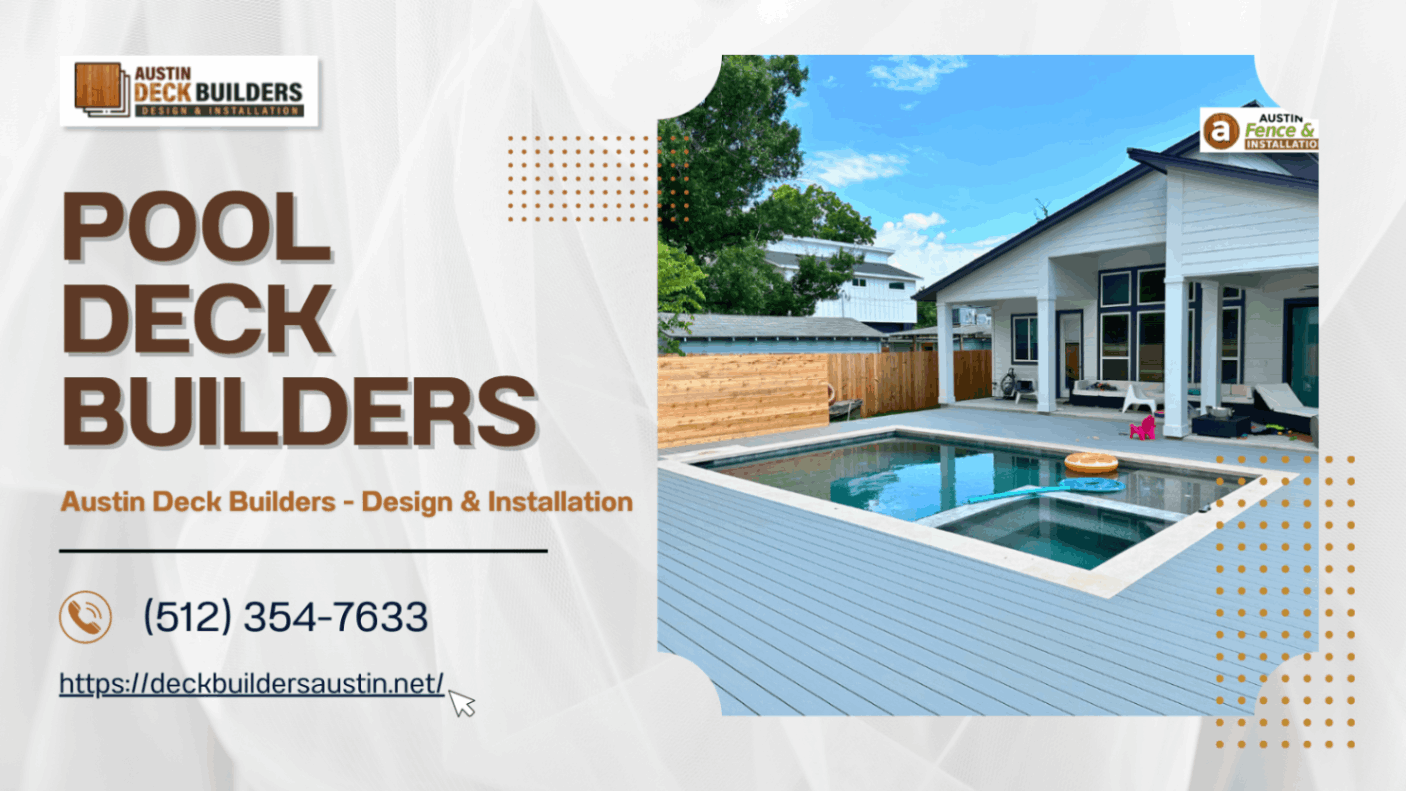

| Entity | Definition |
|---|---|
| Pool Deck Builders | Contractors who design and build decks surrounding pools, focusing on safety and aesthetics. |
| Custom Deck Builders | Deck professionals who offer customized designs based on client preferences, materials, and site conditions. |
| Wood Deck Builders | Deck builders who specialize in traditional wood decks using materials like cedar, redwood, or pressure-treated lumber. |
| Deck Design Services | Planning and drafting custom layouts, styles, and materials for deck installations. |
| Deck Installation Contractors | Licensed professionals responsible for installing decks according to design specifications and codes. |
Austin Deck Builders – Outdoor Spaces Designed for Real Life
A great deck starts with great design—and Austin Deck Builders is here to make sure your outdoor space works beautifully for everyday life. From sunrise coffee spots to sunset dinners with friends, we create decks that serve as functional extensions of your home, thoughtfully built for the way you live.
Every project starts with a one-on-one consultation to get a full picture of your goals, needs, and budget. We’ll help you choose the right materials—wood or composite—and design features that bring your vision to life. Built-in benches, lighting, shade options, and multi-tiered layouts are just some of the ways we help personalize your space.
Our skilled builders work with precision and care, using best-in-class construction methods to ensure your deck stands up to time and weather. We’re proud to deliver sturdy, code-compliant decks that are as safe and solid as they are stylish.
We make the process smooth and stress-free. Clear communication, fair pricing, and dependable scheduling are all part of the Austin Deck Builders difference. We treat your home with respect and leave behind nothing but quality work and a clean space.
Let us help you create an outdoor area where you’ll love to spend time. Contact Austin Deck Builders and start designing your perfect backyard today.
When it comes to maintaining the integrity of your roof, assessing the condition of the deck is a crucial first step. The deck serves as the foundation for all roofing materials and must be in good shape to ensure longevity and protection against the elements. Look for signs of water damage, rot, warping, or pest infestation. If these issues are localized and not widespread, repair may be a viable option. However, if you notice that these problems are pervasive throughout the decking, this could indicate a need for complete replacement.
The age of your roof deck plays a significant role in deciding whether to repair or replace it. Different materials have varying lifespans; for example, pressure-treated lumber may last longer than untreated wood panels. If your roof deck is nearing the end of its expected service life, repairs might only offer a temporary fix before replacement becomes inevitable. Weighing up these factors can help determine whether investing in repairs is cost-effective or if it's time to opt for new decking.
Cost is often a determining factor when choosing between deck repair and replacement. Repairs are generally less expensive in the short term but consider whether they will add lasting value or simply delay more significant expenses down the line. A thorough inspection by a professional can provide an estimate for both options, allowing you to compare immediate costs versus long-term investments. Remember that while replacing your roof deck might have higher upfront costs, it could save money over time through improved energy efficiency and reduced maintenance needs.
Safety should never be compromised when dealing with structural components like your roof deck. If there's any question about its ability to support weight or withstand severe weather conditions safely after patch-up jobs, err on the side of caution with replacement rather than risking potential collapse or injury later on. This consideration is especially pertinent if you live in an area prone to heavy snowfall, hurricanes, or other extreme weather events that exert additional stress on roofing structures.
Ultimately, deciding between repairing or replacing your roof deck requires careful consideration of several factors including its current condition, age relative to lifespan expectations of materials used in construction; cost implications concerning short-term fixes versus longer-term solutions; and safety concerns associated with structural integrity under various environmental stresses encountered throughout seasons year-round where property located resides geographically speaking (e.g., areas known for harsh weather patterns). Consulting with roofing professionals who can provide detailed assessments regarding state-of-affairs concerning aforementioned points will help inform which course action best suits individual circumstances at hand - ensuring reliable cover overhead keeping home secure from outside elements now into future years come.
The journey to a new deck begins with careful planning and design. This initial phase involves determining the purpose of the deck, its size, shape, and location. Considerations regarding the roof structure are key if the deck is to be attached or adjacent to it; ensuring that any penetrations for footings or attachments are properly waterproofed and structurally sound. During this stage, homeowners should also familiarize themselves with local building codes and obtain necessary permits before moving forward.
Choosing the right materials is crucial for both the longevity of the deck and its aesthetic integration with the house roof. Options range from traditional wood like cedar or redwood, which blend well with natural environments, to composite materials that offer durability and lower maintenance. For a rooftop deck, materials must be chosen not only for their appearance but also for their weight and how they will interact with existing roofing materials to ensure no damage is incurred.
With plans in place, groundwork begins by clearing the area where the deck will be constructed. For ground-level decks, this might involve leveling the terrain and laying a weed barrier. The foundation is paramount; whether it requires concrete piers set below frost lines or adjustable pier systems designed for rooftop applications where direct attachment must consider integrity of the roof membrane. Properly installed foundations ensure stability against both uplift and settling over time.
Once foundations are set, framing can commence—the skeleton upon which your deck will take shape. Pressure-treated lumber is typically used for framing due to its resistance to rot and pests—an important consideration under various weather conditions including those experienced at elevated positions near roofs. Joists are laid out in accordance with design specifications while ledger boards must be securely fastened to existing structures ensuring safe load transfer without compromising any roofing elements.
After framing comes decking—the visible surface of your new outdoor space. Deck boards are carefully measured, cut, and secured into place over joists providing an even walking surface that complements your home's architecture including aspects related to roofing such as eaves or overhangs. Finally, finishing touches such as railings for safety (especially relevant on rooftop decks), stairs for access if required, trim work around edges or features like built-in seating add functionality while enhancing overall aesthetics of your new recreational area nestled beneath or beside your home's protective canopy—the roof.

Yes, but it's minimal just routine cleaning to prevent buildup. No staining or sealing required.
Remodeling focuses on upgrading style or features (like railings or layouts), while replacement involves removing and rebuilding due to age or damage.
Signs of unsafe decks include loose boards, wobbly railings, visible rot, rusted fasteners, or uneven surfaces. A contractor can perform a safety inspection.